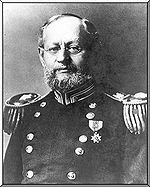 WHO IS THIS GUY AND WHY IS HE SHOWING UP IN MY BLOG? Well, tell me if this board meeting agenda line-up sounds familiar to you: call to order, reading of the minutes, reports of officers, reports of standing and ad hoc committees, director's report, unfinished or old business, new business, adjournment.
WHO IS THIS GUY AND WHY IS HE SHOWING UP IN MY BLOG? Well, tell me if this board meeting agenda line-up sounds familiar to you: call to order, reading of the minutes, reports of officers, reports of standing and ad hoc committees, director's report, unfinished or old business, new business, adjournment. It's likely that this agenda (or something similar) is familiar to most of you in the US, because it comes from Robert's Rules of Order, Henry M. Robert's parliamentary playbook first published in 1876 as the Pocket Manual of Rules of Order for Deliberative Assemblies. I think you can tell by the General's picture that he was a no-nonsense kind of guy. Robert's Rules moves citizen leaders through the paces of decision-making with military precision.
Since most cultural nonprofits are a L-O-N-G way from the top-down rigidity of military convention (nor composed of hundreds of board members), Robert's Rules has been an uneasy fit. I think most organizations pick and choose pieces from Robert's Rules and leave the headier stuff of subsidiary, privileged and incidental motions, assignment of the floor, and disciplinary procedures to large, highly structured bodies (like Congress).
A case in point is the board meeting agenda. The agenda is the content roadmap for discussion and decision-making. As with any road map, there are several ways of getting from point A to point B. Thanks to Henry Robert, many boards resort to auto-pilot when it comes to agenda planning. As a result, meeting formats are relatively predictable and often lack opportunities for real engagement and consensus-building. There's a balance to be struck at every board meeting, I think, and that has to do with moving meaningful discussion forward where all are encouraged to participate to reach decision points that can be documented and verified.
Much has been written about how to breathe life into agendas and routine meetings. I'll point out a few of my favorite suggestions:
- move the most important or urgent discussions to the top or middle of the agenda (wherever you know you'll have the most people in attendance)
- ditch verbal reports that rehash past activity (send them out beforehand in written form)
- cluster discussions under the goals of your strategic plan
- always set aside time to tackle broad issue discussions, invite staff presentations, visit a part of the physical plant or engage in some self-assessment
This means you'll need to build each meeting's agenda almost from scratch -- and that's a healthy thing. It will require you to always ask questions about what the meeting needs to accomplish and to answer those questions with a refreshing mix of content presenters. As a result, you'll be seeking wider input in agenda creation -- and that's a really healthy thing.


Comments